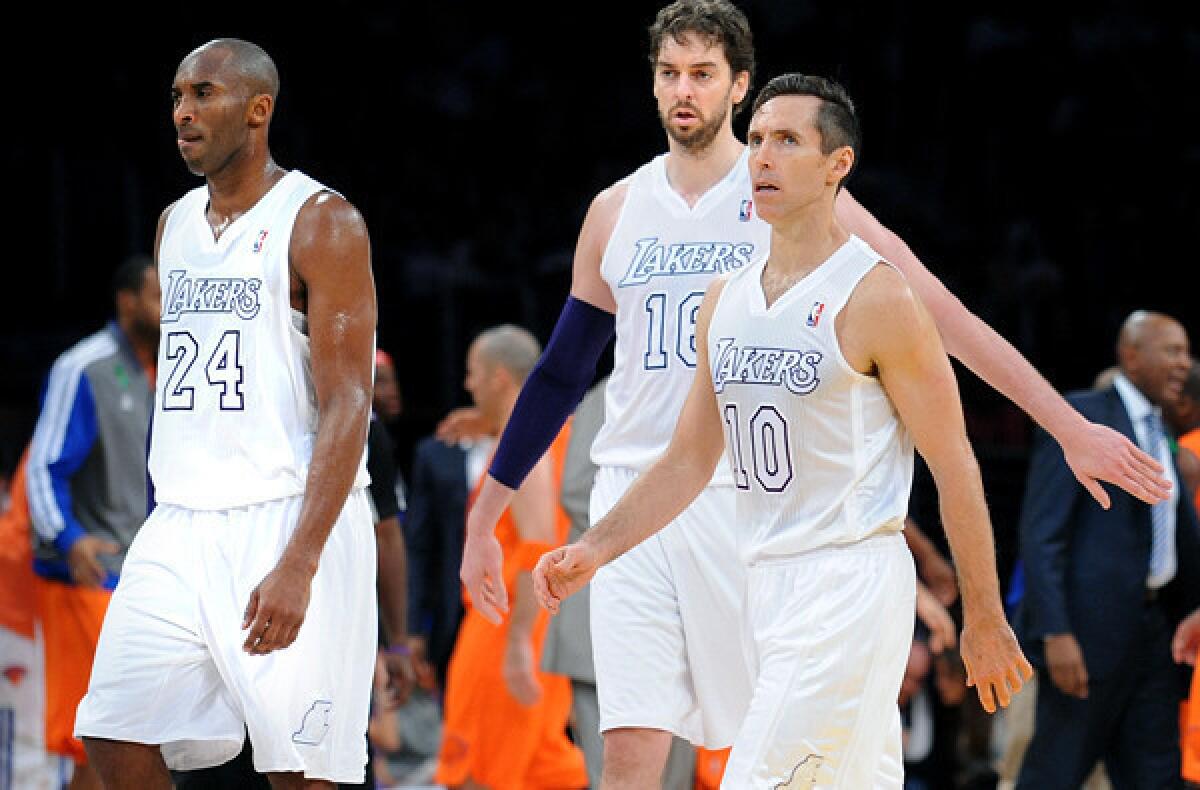Lakers limited by luxury taxes

The hardest sell at the Staples Center’s Team L.A. store might be a Lakers jersey with the name “Cap Room” on the back.
“They’re a mess,” former Lakers coach Phil Jackson said in June. “We know that because of their financial disorder right now, that’s the thing they have to get straight right away.”
The Lakers haven’t been under the NBA’s salary cap since before the 1996-97 season, though the franchise has won five titles since then.
But with Dwight Howard having gone to Houston and Kobe Bryant facing an uncertain return date from Achilles’ tendon surgery, the Lakers’ prospects on the court next season are anything but certain.
The Lakers have struggled to improve their current roster because they are limited by the NBA’s new labor contract. As a “luxury-tax team,” the Lakers have fewer tools to sign players than teams with much lighter payrolls.
For example, the move that allowed the Lakers last summer to bring in Steve Nash is gone. Nash, a free agent, was acquired via a “sign-and-trade” with the Phoenix Suns for draft considerations.
But as a tax-paying team, the Lakers are now forbidden to sign-and-trade for players — one of the many rule changes limiting big-budget franchises.
Longer-term, the Lakers’ rebuilding plans will depend in part on how willing they are to pay the NBA’s increasingly punishing taxes on teams carrying big payrolls.
Each year the NBA sets a spending limit that triggers the luxury tax. In eight of the last 10 seasons, the Lakers have willingly crossed that line. The penalty has been a dollar-for-dollar tax, costing the Lakers a cumulative $113.7 million since the 2002-03 season.
Last season the Lakers’ $99.9-million payroll triggered a tax bill of $29.6 million, the most they have paid in a single season.
And under the NBA’s new labor deal, the tax penalties get even more severe starting this season.
In the 2013-14 season the luxury tax threshold will be $71.75 million.
For the first $5 million any team spends over the line, it will pay $1.50 in tax for each additional dollar of player salaries. The next $5 million a team is over the line will cost them $1.75 per dollar of salaries, and the tax rate keeps rising for every $5 million over the salary threshold. The luxury tax money is distributed to the non-tax-paying teams.
The Lakers’ payroll for the 2013-14 season is expected to be $78.3 million — with $10.2 million owed in luxury taxes.
Many NBA owners wanted a hard salary cap to stop teams from overspending. This progressive tax rate was a compromise — and most teams are being more careful about their payrolls in the upcoming seasons. The one clear exception is Russian billionaire Mikhail Prokhorov, who owns the Brooklyn Nets.
The Nets boast a lengthy list of well-compensated stars such as Deron Williams, Kevin Garnett, Joe Johnson and Paul Pierce. The Nets’ $102.2-million roster this season will cost Prokhorov $87.2 million in taxes.
If the Lakers had re-signed Howard, their tax bill would have been nearly $75 million this season.
Compounding matters, the NBA will start levying a “repeater” tax starting in the 2014-15 season. Teams that are over the luxury tax for three of the previous four seasons become “repeat offenders” and must pay a dollar-for-dollar tax on top of their regular tax bill.
The Lakers figure to escape any taxes — at least for the 2014-15 season.
Next summer the Lakers will have only $10.6 million in guaranteed salary for two players (Robert Sacre and Nash). So the team could have $50 million to spend on free agents, although any amount paid to re-sign Bryant will reduce that number.
In 2014 the free-agent wish list could include: LeBron James, Carmelo Anthony, Chris Bosh, Dwyane Wade, Zach Randolph, Rudy Gay, Danny Granger, Luol Deng and Marcin Gortat. Restricted free agents could be Paul George, DeMarcus Cousins and Greg Monroe.
If Bryant re-signs next summer for, say, $12 million for the 2014-15 season, the Lakers would have enough room to sign two more big-name players, enabling the team to stay under the luxury tax.
Then in the summer of 2015 possible free agents include LaMarcus Aldridge, Marc Gasol, Kevin Love and Rajon Rondo. If the Lakers properly manage their budget, they could have enough money to land another decent free agent.
One tool the Lakers won’t have is the ability to trade away first-found draft picks years in advance.
The Lakers have already dealt their 2015 first-round pick to acquire Nash and their 2017 first-round pick for Howard. Because of NBA rules, the Lakers cannot trade away future first round picks in consecutive years. Therefore, the Lakers’ 2014, 2016 and 2018 first-round picks cannot be traded — the earliest available pick would be in 2019.
There is a loophole to the rule, however. The Laker can agree to trade any of those first-round picks, but not until after they select a player on draft day. For example, the 2014 pick can be dealt away immediately following the 2014 draft — but not before.
Meanwhile, despite Howard’s exit, the Lakers are still a destination franchise in the NBA. It shouldn’t take long for the team to lure two or three star players via free agency.
But once they do, the cycle of $100-million payrolls, luxury taxes and limited flexibility starts anew.
More to Read
Go beyond the scoreboard
Get the latest on L.A.'s teams in the daily Sports Report newsletter.
You may occasionally receive promotional content from the Los Angeles Times.










